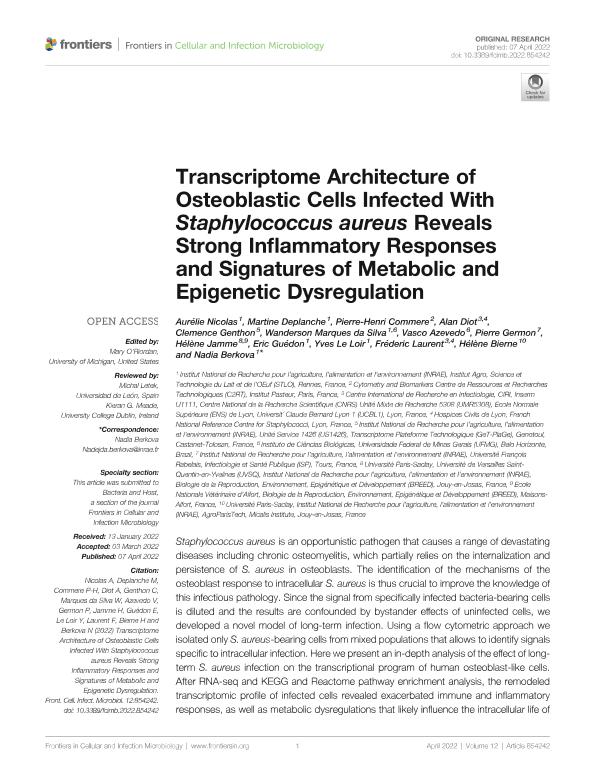Mostrar el registro sencillo del ítem
dc.contributor.author
Nicolas, Aurélie
dc.contributor.author
Deplanche, Martine
dc.contributor.author
Commere, Pierre Henri
dc.contributor.author
Diot, Alan
dc.contributor.author
Genthon, Clemence
dc.contributor.author
Marques Da Silva, Wanderson

dc.contributor.author
Azevedo, Vasco
dc.contributor.author
Germon, Pierre
dc.contributor.author
Jamme, Hélène
dc.contributor.author
Guédon, Eric
dc.contributor.author
Le Loir, Yves
dc.contributor.author
Laurent, Fréderic
dc.contributor.author
Bierne, Hélène
dc.contributor.author
Berkova, Nadia
dc.date.available
2023-10-10T17:39:02Z
dc.date.issued
2022-04
dc.identifier.citation
Nicolas, Aurélie; Deplanche, Martine; Commere, Pierre Henri; Diot, Alan; Genthon, Clemence; et al.; Transcriptome Architecture of Osteoblastic Cells Infected With Staphylococcus aureus Reveals Strong Inflammatory Responses and Signatures of Metabolic and Epigenetic Dysregulation; Frontiers Media; Frontiers in Cellular and Infection Microbiology; 12; 4-2022; 1-20
dc.identifier.issn
2235-2988
dc.identifier.uri
http://hdl.handle.net/11336/214737
dc.description.abstract
Staphylococcus aureus is an opportunistic pathogen that causes a range of devastating diseases including chronic osteomyelitis, which partially relies on the internalization and persistence of S. aureus in osteoblasts. The identification of the mechanisms of the osteoblast response to intracellular S. aureus is thus crucial to improve the knowledge of this infectious pathology. Since the signal from specifically infected bacteria-bearing cells is diluted and the results are confounded by bystander effects of uninfected cells, we developed a novel model of long-term infection. Using a flow cytometric approach we isolated only S. aureus-bearing cells from mixed populations that allows to identify signals specific to intracellular infection. Here we present an in-depth analysis of the effect of long-term S. aureus infection on the transcriptional program of human osteoblast-like cells. After RNA-seq and KEGG and Reactome pathway enrichment analysis, the remodeled transcriptomic profile of infected cells revealed exacerbated immune and inflammatory responses, as well as metabolic dysregulations that likely influence the intracellular life of bacteria. Numerous genes encoding epigenetic regulators were downregulated. The later included genes coding for components of chromatin-repressive complexes (e.g., NuRD, BAHD1 and PRC1) and epifactors involved in DNA methylation. Sets of genes encoding proteins of cell adhesion or neurotransmission were also deregulated. Our results suggest that intracellular S. aureus infection has a long-term impact on the genome and epigenome of host cells, which may exert patho-physiological dysfunctions additionally to the defense response during the infection process. Overall, these results not only improve our conceptual understanding of biological processes involved in the long-term S. aureus infections of osteoblast-like cells, but also provide an atlas of deregulated host genes and biological pathways and identify novel markers and potential candidates for prophylactic and therapeutic approaches.
dc.format
application/pdf
dc.language.iso
eng
dc.publisher
Frontiers Media

dc.rights
info:eu-repo/semantics/openAccess
dc.rights.uri
https://creativecommons.org/licenses/by-nc-sa/2.5/ar/
dc.subject
EPIGENETICS
dc.subject
IMMUNE RESPONSE
dc.subject
METABOLISM
dc.subject
OSTEOBLASTS
dc.subject
PERSISTENCE
dc.subject
STAPHYLOCOCCUS AUREUS
dc.subject
TRANSCRIPTOMICS
dc.subject.classification
Biología Celular, Microbiología

dc.subject.classification
Ciencias Biológicas

dc.subject.classification
CIENCIAS NATURALES Y EXACTAS

dc.title
Transcriptome Architecture of Osteoblastic Cells Infected With Staphylococcus aureus Reveals Strong Inflammatory Responses and Signatures of Metabolic and Epigenetic Dysregulation
dc.type
info:eu-repo/semantics/article
dc.type
info:ar-repo/semantics/artículo
dc.type
info:eu-repo/semantics/publishedVersion
dc.date.updated
2023-07-08T00:33:06Z
dc.journal.volume
12
dc.journal.pagination
1-20
dc.journal.pais
Suiza

dc.description.fil
Fil: Nicolas, Aurélie. No especifíca;
dc.description.fil
Fil: Deplanche, Martine. No especifíca;
dc.description.fil
Fil: Commere, Pierre Henri. Institut Pasteur de Paris.; Francia
dc.description.fil
Fil: Diot, Alan. Inserm; Francia
dc.description.fil
Fil: Genthon, Clemence. No especifíca;
dc.description.fil
Fil: Marques Da Silva, Wanderson. Universidade Federal de Minas Gerais; Brasil. Instituto Nacional de Tecnología Agropecuaria. Centro de Investigación en Ciencias Veterinarias y Agronómicas. Instituto de Agrobiotecnología y Biología Molecular. Consejo Nacional de Investigaciones Científicas y Técnicas. Oficina de Coordinación Administrativa Parque Centenario. Instituto de Agrobiotecnología y Biología Molecular; Argentina
dc.description.fil
Fil: Azevedo, Vasco. Universidade Federal de Minas Gerais; Brasil
dc.description.fil
Fil: Germon, Pierre. Universite de Tours; Francia
dc.description.fil
Fil: Jamme, Hélène. Universite Paris-Saclay;
dc.description.fil
Fil: Guédon, Eric. No especifíca;
dc.description.fil
Fil: Le Loir, Yves. No especifíca;
dc.description.fil
Fil: Laurent, Fréderic. Inserm; Francia
dc.description.fil
Fil: Bierne, Hélène. Universite Paris-Saclay;
dc.description.fil
Fil: Berkova, Nadia. No especifíca;
dc.journal.title
Frontiers in Cellular and Infection Microbiology
dc.relation.alternativeid
info:eu-repo/semantics/altIdentifier/doi/http://dx.doi.org/10.3389/fcimb.2022.854242
Archivos asociados
